|
Costa Brava
is the name given to the Northern part of the Catalan coast line; with
a length of 214 Kms which extends between the French frontier to the
mouth of the river Tordera, close to Blanes, integrating in its territory the coastal regions of Alt Empordà, Baix Empordà and La Selva, and the inland regions of Gironès and Pla de l'Estany which lead you along to the hearth of the Old Catalonia and Pyrenean areas as La Garrotxa, El Ripollès and La Cerdanya.
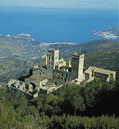 In the confluence of Mountains and Sea, the Mediterranean and the Pyrenees,
where the Mountains get gently into the sea, drawing and sheltering
beautiful sandy beaches, wide bays, small hidden creeks and
extraordinary sea cliffs. Not far from the coastal line, we find cities
like Girona (the Immortal), Figueres (the Genial), Besalú (the Medieval), Olot (the nature) La Bisbal (the Ceramics), Santa Coloma (the Thermal waters), Banyoles (the Lake), Ripoll (the cradle of Catalonia) and Puigcerdà (the high Pyrenees), each one watching over its treasures.
In the confluence of Mountains and Sea, the Mediterranean and the Pyrenees,
where the Mountains get gently into the sea, drawing and sheltering
beautiful sandy beaches, wide bays, small hidden creeks and
extraordinary sea cliffs. Not far from the coastal line, we find cities
like Girona (the Immortal), Figueres (the Genial), Besalú (the Medieval), Olot (the nature) La Bisbal (the Ceramics), Santa Coloma (the Thermal waters), Banyoles (the Lake), Ripoll (the cradle of Catalonia) and Puigcerdà (the high Pyrenees), each one watching over its treasures.
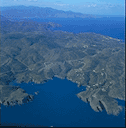 The Alt Empordà
region is the one that better shows us those contrast of Nature. The
landscape of the area has many referent points. In the north, the Pyrenees
losing height end in the Cap the Creus peninsula getting smoothly into
the sea. Down the hills the fertile plain of Emporda is drown, with Figueres
as the main human concentration, capital of the area and meeting point
of all the ways crossing the area. Important shopping centre, and birth
place of the famous artist Salvador Dalí. The visit of his Theather-Museum is a must. Finally the coast with the impressive Gulf of Roses.
The Alt Empordà
region is the one that better shows us those contrast of Nature. The
landscape of the area has many referent points. In the north, the Pyrenees
losing height end in the Cap the Creus peninsula getting smoothly into
the sea. Down the hills the fertile plain of Emporda is drown, with Figueres
as the main human concentration, capital of the area and meeting point
of all the ways crossing the area. Important shopping centre, and birth
place of the famous artist Salvador Dalí. The visit of his Theather-Museum is a must. Finally the coast with the impressive Gulf of Roses.
We can also find very interesting Natural and ecological protected areas, such as The Natural Park of Cap de Creus, the Natural Park of Aiguamolls de l'Emporda, The Albera National Interest Natural Place and the Natural Park of Montgrí, Illes Medes and Baix Ter.
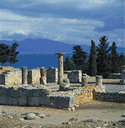 And
that is not all. It is, by sure, the human factor that has personalized
this land and left us to discover the steps of the past. We can find
megalithic monuments, Iberian villages, Greek&Roman cities,
Romanesque churches and monasteries, Gothic and Baroque , either
religious or civil buildings and also the XIX century Modernist style,
all of them very well looked after, defining the culture of a country,
the Catalan, proud of such superb legacy, inheritor of the wise Greek,
the Roman Craftsman, the Iberian warrior, the Merchant, the Saylor, the
Peasant, the Artist, The Genius, the Man and specially the Freedom,
qualities that only the climate can redefine. And
that is not all. It is, by sure, the human factor that has personalized
this land and left us to discover the steps of the past. We can find
megalithic monuments, Iberian villages, Greek&Roman cities,
Romanesque churches and monasteries, Gothic and Baroque , either
religious or civil buildings and also the XIX century Modernist style,
all of them very well looked after, defining the culture of a country,
the Catalan, proud of such superb legacy, inheritor of the wise Greek,
the Roman Craftsman, the Iberian warrior, the Merchant, the Saylor, the
Peasant, the Artist, The Genius, the Man and specially the Freedom,
qualities that only the climate can redefine.
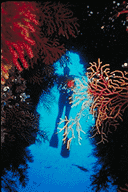 The
weather in this area is Mediterranean, with an annual average of 16,80º
centigrade and 73 days of rain average. This means a very mild and
pleasant climate all year though. The
weather in this area is Mediterranean, with an annual average of 16,80º
centigrade and 73 days of rain average. This means a very mild and
pleasant climate all year though.
Weather data of Roses:

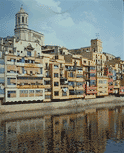 Its situation, at less then 24 hours reach of the big European Cities, makes it visit able for all European people. The Costa Brava
was one of the first littoral areas that interested itself in the
reception of the first tourist that came to our country looking for a
good climate and authentic vacations. The hospitality of the locals,
together with the beautiful landscape and interesting historical legacy
made possible the avalanche of demands from the visitors, and obviously
the necessary tourist offer to satisfy them.
Today, seaside resorts as Tossa de Mar, Lloret de Mar, Roses, Platja d'Aro, Begur, Cadaqués and L'Escala are known world over. And cities like Figueres, Girona and Olot have become very important cultural resorts.
Its situation, at less then 24 hours reach of the big European Cities, makes it visit able for all European people. The Costa Brava
was one of the first littoral areas that interested itself in the
reception of the first tourist that came to our country looking for a
good climate and authentic vacations. The hospitality of the locals,
together with the beautiful landscape and interesting historical legacy
made possible the avalanche of demands from the visitors, and obviously
the necessary tourist offer to satisfy them.
Today, seaside resorts as Tossa de Mar, Lloret de Mar, Roses, Platja d'Aro, Begur, Cadaqués and L'Escala are known world over. And cities like Figueres, Girona and Olot have become very important cultural resorts.
ROSES
Roses
is a fisherman and tourist resort, situated in the Northeast of
Catalonia. If you choose to spend your holiday in Roses, you will enjoy
some large beaches and lonely isolated coves with clean clear waters.
You will also be able to practise every type of water sport (sailing,
water skiing, surfing, etc.) If you prefer, you can go on a boat trip
along the coast as far as Cap de Creus. You can also discover Roses
going for a ride on the Tourist little train over the hills with
magnificent panorama over the bay.
Roses has a complete infrastructure of apartments, hotels, camping sites, shops, discos and pubs.
Roses coastline has a total of 19 beaches, some with more than 184.000 square meters of sand. The residential part of Roses (Santa Margarita), has more them 18 kilometres of navigable canals. Roses
offers to the visitors the possibility to enjoy the nature of small
coves where you won't hear a lot more than the whispering of the sea
and the cry of the seagulls.
The Mallol House, The fishermen's Monument, the Monument to the Bay
and to the Tourist, The Harbour, The Light House and the newly built
sea-front promenade are worth to see and visit. Interesting are also
the Dolmen and the old Citadel.
One should not forget to taste the typical dish from Roses : The Suquet de Peix.
Interesting are also the Dolmen and the Citadel:
DOLMEN CREU D'EN COBERTELLA:
Now we are in front of the biggest dolmen of Catalonia. Since 1964 it
is recognized officially for its cultural and historical value. The
dolmen consists of a closed gallery of 2,45 m breadth, 5,20 m length
and 2,14 m. height. The slab that covers this dolmen is the biggest of
all known in Catalonia with around 4 tons of weight
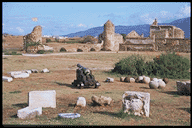 THE
CITADEL:
This military compound is situated to your right hand when you drive in
direction to Figueres.
It was constructed under the reign of King Charles V. of Germany who is
known in Spain as Carlos I of Spain. While the original construction
dates of 1543, the impressive PORTAL TO THE SEA was erected during the
Renaissance period. THE
CITADEL:
This military compound is situated to your right hand when you drive in
direction to Figueres.
It was constructed under the reign of King Charles V. of Germany who is
known in Spain as Carlos I of Spain. While the original construction
dates of 1543, the impressive PORTAL TO THE SEA was erected during the
Renaissance period.
The compound's historical and cultural value was recognized officially
in 1961: the soil protects archaeological treasures since within the
citadel's walls was founded the Greek village Rhodas 776 before Jesus
Christ; as a matter of fact Greeks of the isle of Rhodos had at that
time come over to the Bay of Roses. There also stood the monastery
Santa Maria that was constructed during the XI. century in Lombard
Romanesque style.
 EMPURIABRAVA-CASTELLÓ D'EMPURIES
EMPURIABRAVA-CASTELLÓ D'EMPURIES
In the past, Castelló d'Empúries was the capital of the county of Empuries. Nowadays is an agricultural, cattle raising, and of course important tourist town.
The Parish Church of Santa Maria, which the Count Pere the 1st wanted
to convert into a cathedral, has a 69 meters high bell tower. This
three nave gothic church, has its bell tower in Romanesque style. The
main altar is in alabaster. The marble porch is very fine decorated.
The old building of the Market, is also in gothic style, being nowadays
the Town Hall.
Another interesting building in Castelló d'Empúries
is the "Curia-Preso", (Curia and Prison) is also in gothic style, and
is being restored to become the Historical Museum of the village.
The flour mill in Castelló d'Empúries has been converted into an "ecological Museum"
The Butterfly Museum, close to the village is also worth to visit, just
as well as the Parc Natural del Aiguamolls de l'Emporda, not far from
the village, where we can admire the flora and fauna of the area,
specially the birds.
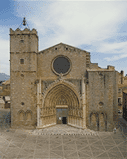 EMPURIABRAVA. Europe's most important residential Marina is situated on the sea side of Castelló d'Empúries
area. Situated between the rivers Muga and Salins, has more then 30
kilometres of navigable canals and a wide sandy beach. Along the
canals, are the villas with their gardens and private jetties.
Empuriabrava is a holiday-makers dream; the shopping areas provide for
everything, it has its own Aerodrome and in the nearby the recreational
zone with shooting range, go-kart circuit, tennis courts, minigolf,
riding school, discotheques, etc.
EMPURIABRAVA. Europe's most important residential Marina is situated on the sea side of Castelló d'Empúries
area. Situated between the rivers Muga and Salins, has more then 30
kilometres of navigable canals and a wide sandy beach. Along the
canals, are the villas with their gardens and private jetties.
Empuriabrava is a holiday-makers dream; the shopping areas provide for
everything, it has its own Aerodrome and in the nearby the recreational
zone with shooting range, go-kart circuit, tennis courts, minigolf,
riding school, discotheques, etc.
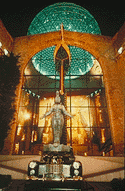 FIGUERES
FIGUERES
Figueres,
the Capital of l'Alt Empordà, is at about 20 kilometres from the
French border. It is an active tourist and commercial centre. The town
is an strategic link of communication. Apart of the AP-7 (motorway) and
the N-II (national road) a great number of local roads starts in
Figueres. Railway and Bus station completes the communication network.
Figueres
was the centre of federal republicanism under the leadership of Abdó
Terrades, and is also de hometown of the utopian socialist Narciso
Monturiol, known mostly as the inventor of the Submarine boat Ictineo.
We find his monument at the bottom of the central promenade "Rambla".
The Parish Church of Sant Pere, built on the XIV century, is in gothic
style and was restored in the 1950's, after being damaged during the
last civil war.
Some interesting buildings can be found, from the beginning of the 20th
century, such as Casino Menestral (1904), Plaça del Gra, and the Parc
Bosc Municipal (1920). Figueres is also known as the birth-place of the "Sardana", the typical dance of the Catalans.
Going up Castle Hill, very close to the Rambla you will find the Theather-Museum Dalí,(where the artist's crypt is), installed in the old Municipal Theater. In 1974 it was inaugurated as a Theather-Museum,
under the direction of Dali himself. The spectacular and emblematic
metallic dome, work of architect Perez Piñero, makes possible to see it
from far away. The neighbouring buildings, now joined to the museum are
decorated in the "Dali style" with enormous eggs on the top, the same
as the Galatea Tower (the old Gorgot tower of the old city walls),
where Salvador Dali spent the last years of his life.
The Dalí Museum is one of the most visited museum in Spain, after the Prado Museum and the Reina Sofia Museum in Madrid.
On the Rambla itself you will find the Catalunya Toy Museum.
This museum has three floors. One is dedicated to a permanent toy
exhibition, with antique objects and archaeological. findings that
belong to the world of toys.
On the Rambla you can also find the Museum of the Empordà, created in 1946 and moved to this modern building in 1970. It has an interesting collection of paintings belonging to the Museo del Prado and the Modern Art Museum in Madrid, as well as a valuable collection of contemporary Catalan paintings.
The largest fortress in Europe is situated north from the town. Sant
Ferran Castle has the form of an star shaped irregular pentagon and a
double enclosure of walls. The building started in 1735. It has a
perimeter of 5 kilometres and numerous bastions, moats, drawbridges and
a beautiful courtyard .
Other interesting places are, Peralada, Pals, Santa Pau, Setcases, Sant Joan de les Abadesses, Castellfollit de la Roca in the interior, and Llançà, Palamós, Palafrugell, Sant Pere Pescador, L'Estartit, Sant Feliu de Guíxols and Blanes, on the coast. Also interesting are, The Volcanic Zone of La Garrotxa, the Natural Park of Montseny, and the Pyrenean Valleys of Muga, Camprodon, Ribes and Núria.
|
 COSTA BRAVA
COSTA BRAVA









